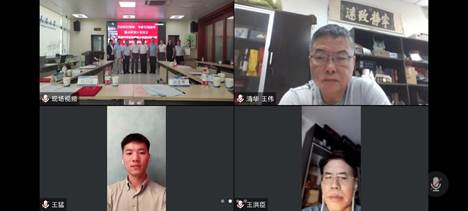On August 28, 2020, a meeting was held at Tianjin University to announce the startup of the project of National Key R&D Program "field-effect micro mass spectrometric technique for rapid discriminant analysis of aromatics and other toxic components in hazardous waste" and its implementation plan demonstration.

Five project demonstration and consulting experts attended the meeting, including Prof. Wang Wei of Tsinghua University, Prof. Wang Hongchen of Renmin University of China, Prof. Chen Guanyi of Tianjin University, researcher Lei Tingzhou of Henan Academy of Sciences, Prof. Feng Yukai of Wuhan University, and Wei Xin, deputy director of Tianjin University’s Finance Department. The meeting also invited Wang Meng, project director of the Administrative Center for China’ s Agenda 21 Century, Hu Wenping, Vice President of Tianjin University, and other 20 representatives, project leaders and key members from leading units, scientific research management departments.
The meeting was held in the form of online and offline combination, and was presided over by Fu Yindan, Vice President of TJU’S Scientific Research Institute. The internal seminar on project implementation was presided over by Prof. Wang Yong, project leader from Tianjin University.
Vice President Hu Wenping delivered an opening speech, stressing that this key project was not only a major breakthrough in the field of resource and environmental protection, but also a landmark achievement of interdisciplinary integration of TJU. He said that TJU would earnestly fulfill its corporate responsibility, and fully support the research work by good coordination and supporting polices. “As the project leading unit, Tianjin University will firmly uphold research integrity, allocate project funds, the use of which will be strictly supervised and standardized, and complete the project on schedule,” Hu noted.
Hu announced the name list of the project demonstration and consultation expert group, who will provide the technical guidance and consultation for the implementation process of the project, and issued the appointment letters on the spot.
Wang Meng introduced the general requirements of the key special project. He stressed that the project should unify the objectives, focus on the application requirements, work closely around the common goal, and make long-term investments for specific goals to promote major breakthroughs in related technologies.
Prof. Wang Yong presented the objectives and contents of the project, the overall integration requirements and key node mileage of the project, and further clarified the organization and management mechanism of the project and the communication and coordination mechanism of the project team on the basis of the project implementation plan. Detailed reports were presented to the experts by project members on the project objectives, key scientific problems to be solved, research contents and technical routes, assessment indicators and schedule, expected results and risk assessment.
The project demonstration expert group reviewed, questioned and discussed the project implementation plan in detail, and unanimously agreed on it. They also put forward suggestions and requirements to further improve the plan.
Wei Xin explained the financial policies and management requirements relevant to the project and answered some common problems.
After the meeting, Prof. Wang Yong convened a seminar among the project leaders and key members of the project. They studied the management regulations laid out by the national key R & D plan about key projects, learned about the project management measures, and announced the member list of the project management office. The specific implementation requirements are clarified according to the modification suggestions put forward by the expert group.
The implementation period of the project is four years. Focusing on the rapid and accurate identification and accurate quantification of hazardous components such as aromatics in hazardous waste, the research will seek breakthroughs in scientific theories, key technologies and integrated demonstration methods that would help promote the sustainable development of the industry. The project team vowed to go all out to complete all tasks with high quality.
By the School of Science
Editor: Eva Yin






